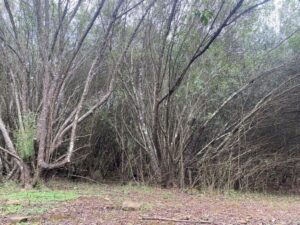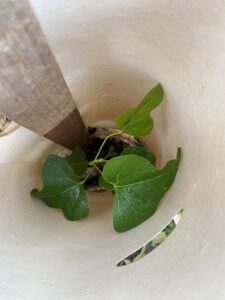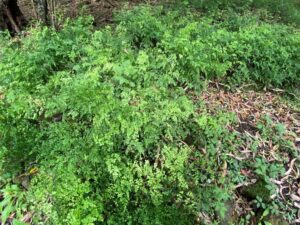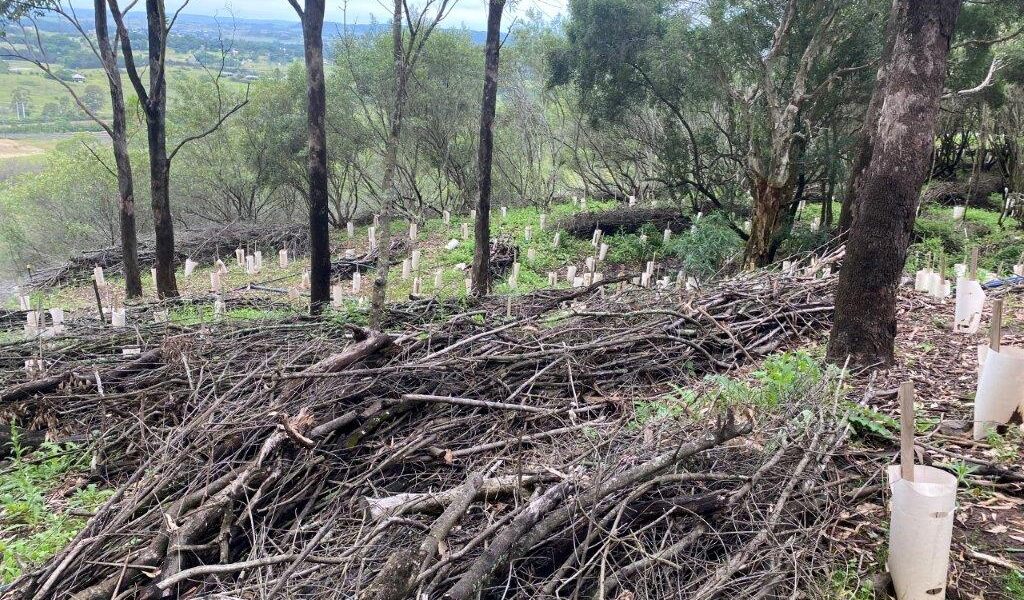Return of the Western Sydney Dry Rainforest
By Michael Elgey
For millennia, the lands in Western Sydney where the Australian Botanic Garden Mount Annan (ABGMA) is located, were home to the First Nations people of the Dharawal Nation. This site was also a meeting place for the Dharug and Gandangara nations, where these three nations met to trade and discuss law and other matters. During these times, the land was cared for under cultural practices which saw three main ecological communities thrive – the Cumberland Plain Woodland (CPW), the Alluvial Woodlands (AW), and the Western Sydney Dry Rainforest (WSDR).
However, during the colonisation of the area in the 1800s, this site lost its cultural practices which were integral to the ecological systems, and then underwent a significant change when the land was cleared for agriculture. Small sections were dug up for small-scale extractive industry between the 1820s and 1850s, and this was followed in the 1880s by the construction of the heritage listed Upper Canal System that runs from Cataract, Cordeaux, Avon and Nepean Dams to Prospect Reservoir. During this time, as the native landscape was being altered, new exotic species started to colonise the landscape. No exotic tree species in this area is more prolific and invasive than the African olive.

The site operated as a dairy farm and subsequently a horse-riding school until 1975. Then, in 1984, the site was selected as the location of a new native botanic garden under the management of the Royal Botanic Gardens (Sydney) and Domain Trust. The site was selected as no additional native vegetation had to be cleared to develop and display the living collection of our vast and unique native flora of Australia, while also contributing to the conservation of endangered remnant populations of native vegetation.

By 2009, there was approximately 80ha of dense African olive forest located across ABGMA. Since then, active management has seen this reduce to less than 10ha as of January 2024. In 2019, a detailed survey was carried out on the southern slopes of Mount Annan under the dense canopy of African olive as it was known that against the odds there were several remnant WSDR species clinging to the slopes after 200 years of environmental disturbance. Unfortunately, what remained was so reduced and scattered that it could not be seen as a functioning WSDR plant community anymore.
Over the years, management practices have been implemented to protect the remnant species under this exotic and undesirable canopy of African olive. Still, as we continued to remove the easier-to-access African olive forest, the time came for us to turn our attention to the staged and staggered removal of the difficult-to-access southern slopes of Mount Annan, that happened to be nurturing remnant species of a once impressive dry rainforest.
In 2022 we decided we would install a small plot within the African olive forest on the southern slopes of Mount Annan and plant out WSDR species that would return a native canopy to this area, and allow us to then slowly but systematically remove the invasive African olive and commence to return a lost plant community. Before any work began, the propagation of WSDR material from our invaluable Living Collection was initiated by our skilled horticulturist and grown within our production nursery facility.

With the grateful support of a Greening Our City Grant from the NSW State Government initiative, in 2023 we commenced our restoration program which saw the selective thinning out of a small section of the African olive forest to increase light penetration, while still supplying enough shade to continue to nurture the light-sensitive remnant species below. The removed debris (branches, logs, tree trunks) was stacked in windrows to assist in retaining leaf litter build-up, reducing water runoff, and deterring the herbivory of plant material. As we unfortunately have a rabbit population on site, we set up rabbit-resistant fencing to the Long & Robley specification. We were also fortunate enough to be able to install a simple irrigation system to assist and increase the success and establishment of our plantings. When planting out our species, due to the degraded shallow rocky soils, the decision was made to water lance the planting holes instead of using augers or hand trowels, to save the wrists of those undertaking the planting out and increase planting success. The plants in the ground quickly put on fresh new growth, but the soil seed bank came alive with native germinates (and some weedy species). During this programming we undertook an additional flora survey and several more species previously not recorded for this small area were identified.
Like all botanic gardens, they are never static. The conservation works the horticulturists undertake with such tenacity behind the scenes, with help from colleagues, contractors, and other key stakeholders, along with accessing our invaluable conservation-based living collection, always blows me away. As we start to see the seeds of success with our program, to return a critically endangered plant community, we are now looking at the expanse of where the WSDR once covered the southern slopes of Mount Annan and are putting further plans in place to one day return this whole escarpment to WSDR.
Michael Elgey
Curator Manager
Australian Botanic Garden Mount Annan
M: 0448 746 414
E: Michael.elgey@botanicgardens.nsw.gov.au
W: botanicgardens.org.au
All images supplied by Australian Botanic Garden Mount Annan
Main photo: Windrows of recently removed African olive branches to reduce water and leaf litter loss

